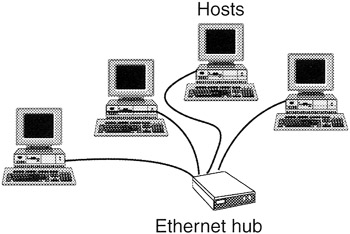16.1 Ethernet
16.1 Ethernet
As described in Chapter 14, specific combinations of NIC, cable, and transmission method are called network technologies. For instance, Ethernet cables, Ethernet cards, and the method that Ethernet cards use to transmit data (CSMA/CD) are jointly referred to as Ethernet. Ethernet is one of the most widely used network technologies and it has gone through several revisions. Some networks still use the original Ethernet technology that was created at Xerox PARC in the 1970s. However, most networks now use one of the newer versions of Ethernet (i.e. 10Base5, 10BaseT, 100BaseT).
16.1.1 10Base5
The 10Base5 standard closely resembles the original Ethernet, relying on a continuous piece of thick (1/2 inch) yellow coaxial cable - the ether. The technology is called 10Base5 because:
-
it can transmit data at 10 Mbits per second;
-
only one computer can transmit while the other listens (this is known as baseband);
-
the maximum recommended cable length is 500 meters (thus the 5 in 10Base5).
To connect a computer to a 10Base5 cable, a transceiver is poked into the cable's yellow plastic sheath at a particular point, indicated with a black mark, essentially tapping into the ether. The transceiver is then connected to the NIC inside the computer using a drop cable. The technical name for this drop cable is Attachment Unit Interface (AUI) (Figure 16.1).

Figure 16.1: Old Ethernet configuration (modern configurations are conceptually the same).
16.1.2 10/100/1000BaseT
The most popular forms of Ethernet are 10BaseT and 100BaseT because they are cheaper and less cumbersome. These network technologies do not require a separate tap, transceiver, and drop cable, only a NIC and cable. 10BaseT and 100BaseT use unshielded twisted-pair (UTP) cables similar to regular telephone cords (two pairs of copper wires twisted together to reduce electrical interference). Unlike the thick yellow cables used by 10Base5, UTP cables are cheap and easy to bend around corners. However, UTP can only carry data about 100 meters whereas a 10Base5 cable can carry data for up to 500 meters. These cables are used to connect hosts to a central hub or switch that transmits data between hosts. A switch is analogous to a train system that enables trains to transfer from one track to another using a switching mechanism (Figure 16.2).

Figure 16.2: Computers on a 10BaseT network plugged into a hub.
The more recent version of Ethernet is 100BaseT, basically the same as 10BaseT except faster. Newer computers are using the latest advance in Ethernet technology; 1000BaseT. Table 16.1 summarizes the main distinguishing features of these standards.
| IEEE 802.3 STANDARD | CABLE | MAX CABLE LENGTH (meters) | THROUGHPUT (Mbps) |
|---|---|---|---|
| 10Base5 (thick Ethernet) | 1/2" Yellow coaxial | 500 | 10 |
| 10BaseT (twisted-pair Ethernet) | Twisted pair | 100 | 10 |
| 100BaseT | Twisted pair | 100 | 100 |
| 1000BaseT | Twisted pair | 100 | 1000 |
16.1.3 CSMA/CD
Although Carrier Sense Multiple Access with Collision Detection (CSMA/CD) is a mouthful, the concept is straightforward: it is a "listen before acting" access method. Recall the analogy of the polite dinner conversation described in Chapter 14. At a polite dinner party, an individual who has something to say waits for a break in the conversation before speaking. If two people start to speak at the same time, they both stop for a moment before starting to speak again. Similarly, when two computers using Ethernet start to transmit data at the same time, they both sense that the other host is transmitting and they both stop for a random period of time before transmitting again. This method of communication works well as long as there are not too many hosts connected to the same wire. Having too many hosts on the network will result in many collisions and not enough successful communication.
EAN: 2147483647
Pages: 279